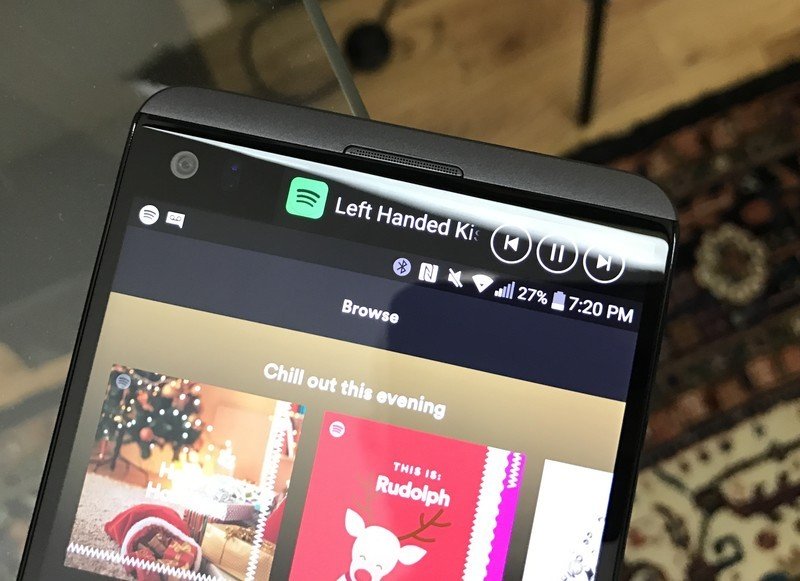The LG V20's Second Screen is a gimmick that actually works

The LG V20 is a big phone with a twist — a second "ticker" display just above the main LCD panel that LG calls the "Second Screen." In reality, it is just a small extension of the main display, but thanks to improvements in battery efficiency and some software smarts, it is able to stay on all the time.
But is the Second Screen a gimmick? And what exactly can you do with that extra space? Let's break it down.
What is the Second Screen?

It's exactly what it sounds like: a place for displaying additional information and quick settings that aren't always in the foreground on a typical Android phones. Its resolution is 1040x160 pixels, which isn't quite as wide as the full width of the 2560x1440 display since it needs to leave room for the front-facing camera and proximity sensors.
LG has seven built-in panels that can be swiped through horizontally:
- Quick Tools (Wi-Fi, Bluetooth)
- App shortcuts (specific apps)
- Recent apps
- Quick contacts
- Music controls
- Signature (By default your name)
- Upcoming plans
Some of these are considerably more useful than others, and I tend only to leave three — quick tools, app shortcuts, and media controls — enabled while the screen is on. The rest merely duplicate existing functionality.
Is it useful?

That's the big question. Andrew Martonik, in his review, dismissed the Second Screen, saying that it doesn't really add much to the experience. Here are his words:
Much like I found with the "edge screen" on the Galaxy S7 edge (and Note 7), the second screen doesn't really do much other than duplicate functions I can already do very quickly elsewhere on the phone. Just as easily as getting to the quick tools I can swipe down the notification shade. Just as quickly as swiping and then tapping on a recent app in the second screen I could just hit the Recents button in the navigation bar ... and so on and so forth. Add to that the fact that the second screen is at the top of an extremely tall phone, and it makes it (literally) a bit less accessible than the same functions elsewhere on the phone.
Now, I agree with most of that, but after using the LG V20 as my main phone for a month, going back to a phone without the second screen feels like it's missing something. Here's why: by default, the second screen shows notifications that would have popped over existing content; you can expand it to create the "real" notification overlay, but generally the second screen version suffices.
Get the latest news from Android Central, your trusted companion in the world of Android
The second screen also works when the main one is off, showing notifications when they appear while at other times offering the same quick tools as when the display is on. It's a system that works most of the time, and unlike the edge display on the Galaxy Note Edge, I never find this one intrusive or frustrating to use.
The best use cases

For me, the best use cases are the simplest.
For me, the best use cases are the simplest: tapping on my most-used apps to quickly get to Slack, 1Password, Todoist, Spotify or Instagram, or quickly toggling Wi-Fi without having to swipe down on the notification shade.
I think LG understands the second screen is there to augment the first, and not to intrude on the primary experience of using Android. That the phone runs Android 7.0, which has an inherently better notification system than anything before it, also helps, since I often find myself relying on inline replies to communicate rather than entering the app itself. The second screen makes it easy to decide whether I should actually take action on a particular notification, since there's a small arrow to the right of the message that lets you expand it to its normal size. Think of it as notification triage.
The other part of the second screen that really works is media control. Having a permanent Spotify toast at the top of the display is just great, and it blends nicely into the rest of the Android experience. Yes, you can just swipe down the notification shade to access he same controls, but this is better.
A reason to buy the V20?
The second screen is one of many features that make the V20 compelling, and while alone it isn't enough to warrant a buy, it's definitely one of those features that impresses passersby and improves the phone's general desirability. Along with its removable battery, the second screen is certainly a check box on a list that includes a great big screen, a fast processor, plenty of storage, two awesome cameras, and a version of Android 7.0 that I've grown to appreciate, if not admire.
That's kind of the confusing aspect of the LG V20. It has so many gimmicky-sounding features on the surface, but they consolidate into something much better than their individual components. The second screen is something special: a gimmick that works, and improves, the whole.

Daniel Bader was a former Android Central Editor-in-Chief and Executive Editor for iMore and Windows Central.



